
The true finches are small to medium-sized passerine birds in the family Fringillidae. Finches generally have stout conical bills adapted for eating seeds and nuts and often have colourful plumage. They occupy a great range of habitats where they are usually resident and do not migrate. They have a worldwide native distribution except for Australia and the polar regions. The family Fringillidae contains more than two hundred species divided into fifty genera. It includes the canaries, siskins, redpolls, serins, grosbeaks and euphonias, as well as the morphologically divergent Hawaiian honeycreepers.
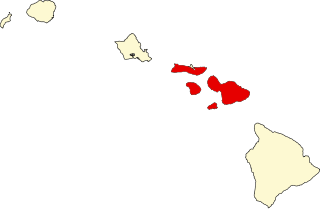
Maui Nui is a modern geologists' name given to a prehistoric Hawaiian island and the corresponding modern biogeographic region. Maui Nui is composed of four modern islands: Maui, Molokaʻi, Lānaʻi, and Kahoʻolawe. Administratively, the four modern islands comprise Maui County. Long after the breakup of Maui Nui, the four modern islands retained plant and animal life similar to each other. Thus, Maui Nui is not only a prehistoric island but also a modern biogeographic region.

The poʻo-uli or Hawaiian black-faced honeycreeper is an extinct species of passerine bird that was endemic to the island of Maui in Hawaiʻi. It is considered to be a member of the Hawaiian honeycreepers, and is the only member of its genus Melamprosops. It had a black head, brown upper parts and pale gray underparts. This bird inhabited only the wetter, easternmost side of Maui, where it had rapidly decreased in numbers. With extinction threatening, efforts were made to capture birds to enable them to breed in captivity. These efforts were unsuccessful; in 2004, only two known birds remained, and since then, no further birds have been sighted. A 2018 study recommended declaring the species extinct, citing bird population decline patterns and the lack of any confirmed sightings since 2004, and in 2019, the species was declared extinct.
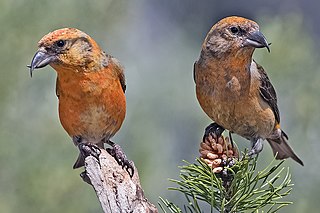
The cardueline finches are a subfamily, Carduelinae, one of three subfamilies of the finch family Fringillidae, the others being the Fringillinae and the Euphoniinae. The Hawaiian honeycreepers are now included in this subfamily. Except for the Hawaiian honeycreepers which underwent adaptive radiation in Hawaii and have evolved a broad range of diets, cardueline finches are specialised seed eaters, and unlike most passerine birds, they feed their young mostly on seeds, which are regurgitated. Besides this, they differ from the other finches in some minor details of their skull. They are adept at opening seeds and clinging to stems, unlike other granivorous birds, such as sparrows and buntings, which feed mostly on fallen seeds. Some members of this subfamily are further specialised to feed on a particular type of seed, such as cones in the case of crossbills. Carduelines forage in flocks throughout the year, rather than keeping territories, and males defend their females rather than a territory or nest.
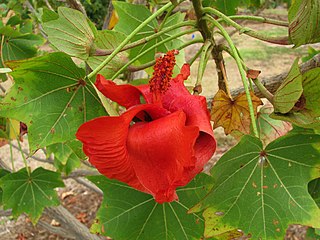
Kokia cookei is a small, deciduous tree commonly known as the kokiʻo, Molokaʻi treecotton, Cooke's kokiʻo, or Molokaʻi kokiʻo.

Akialoa is an extinct genus of Hawaiian honeycreeper in the subfamily Carduelinae of the family Fringillidae. The ʻakialoa species are all extinct, but they formerly occurred throughout Hawaii.

Ciridops is an extinct genus of Hawaiian honeycreeper species that occurred in prehistoric and historic times on the Hawaiian islands of Hawaii, Molokai, Kauai and Oahu. This genus was created in 1892 by Alfred Newton in an article published by the journal Nature on the basis of the ʻula-ʻai-hawane, which was named Fringilla anna by Sanford B. Dole in 1879.
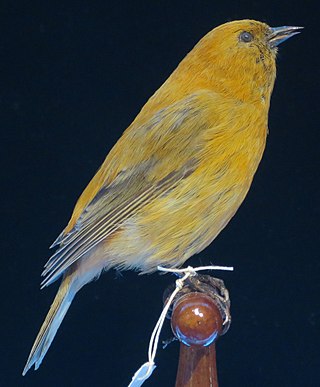
Loxops is a Hawaiian honeycreeper genus in the finch family, Fringillidae. Most of them are commonly known as ʻakepa.

Rhodacanthis, commonly known as the koa finches, is an extinct genus of Hawaiian honeycreeper in the subfamily Carduelinae of the family Fringillidae. All four species were endemic to Hawaii.
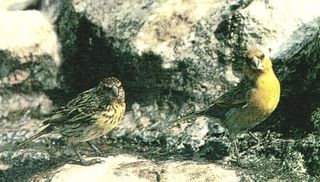
Telespiza is a genus of Hawaiian honeycreeper. All species in it are or were endemic to the Hawaiian Islands.
The highland finch is an extinct member of the Fringillidae and a Hawaiian honeycreeper which is known only from a few bones found in caves. It is the only member of the genus Orthiospiza. It was endemic to the high-elevation areas of Mount Haleakalā on the Hawaiian island of Maui. It has been speculated that they were pushed to extinction because of habitat loss. It is known only from fossil remains and likely became extinct before the first Europeans arrived in 1778.
The Kauai finch is an extinct bird in the genus Telespiza of the family Fringillidae. It was endemic to the Hawaiian islands of Kauai and Oahu. It is only known from fossil remains and likely became extinct before the first Europeans visited Hawaii in 1778.
The wahi grosbeak or Oʻahu grosbeak is a prehistoric species of Hawaiian honeycreeper. The wahi grosbeak was endemic to dry forests on the Hawaiian islands of Kauaʻi, Oʻahu, and Maui. Based on the thickness of its bill it fed on seeds easier to crack than those of the naio, on which the Kona grosbeak fed. The species was already extinct when Europeans landed on the island. Being only known from fossils, its behavior and the exact reasons for its extinction are essentially unknown. Its fossils have been found throughout the islands, but were present in higher concentrations in caves. The bird was smaller than the related King Kong grosbeak by 2 inches (5.1 cm). It had a total length of 9 inches (23 cm).
The King Kong grosbeak or giant grosbeak is a prehistoric species of Hawaiian honeycreeper, that was endemic to Hawaiʻi. It had the largest beak of the three Chloridops species known to have existed. The King Kong grosbeak was described from fossils found at Barber's Point and Ulupau Head on the island of Oʻahu. It was 11 inches (28 cm) long, making it one of the largest Hawaiian honeycreepers. The osteology of the mandible strongly suggests that C. regiskongi was a sister-taxon of Rhodacanthis.

The high-billed crow or deep-billed crow was a species of large, raven-sized crow that was endemic to the island of Oahu in the Hawaiian Islands. It was pushed to extinction due to the arrival of people and pests like rats.
Paleontology or palaeontology is the study of prehistoric life forms on Earth through the examination of plant and animal fossils. This includes the study of body fossils, tracks (ichnites), burrows, cast-off parts, fossilised feces (coprolites), palynomorphs and chemical residues. Because humans have encountered fossils for millennia, paleontology has a long history both before and after becoming formalized as a science. This article records significant discoveries and events related to paleontology that occurred or were published in the year 1991.
The stout-legged finch is an extinct species of finch, in the 'Hawaiian honeycreeper' group. Subfossil remains have been found only on the island of Kauai and indicate that it survived up until the late Quaternary period. It probably died out when the first humans arrived in the Hawaiian Islands. The stout-legged finch would have been very vulnerable to the pests and agriculture that the humans brought with them. It was a congener of the 'ula-'ai-hawane, and therefore probably had similar colors of red, white and black.
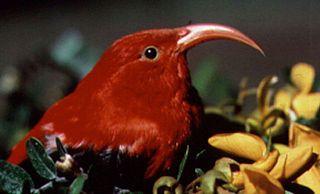
Hawaiian honeycreepers are a group of small birds endemic to Hawaiʻi. They are members of the finch family Fringillidae, closely related to the rosefinches (Carpodacus), but many species have evolved features unlike those present in any other finch. Their great morphological diversity is the result of adaptive radiation in an insular environment. Many have been driven to extinction since the first humans arrived in Hawaii, with extinctions increasing over the last two centuries following European discovery of the islands, with habitat destruction and especially invasive species being the main causes.
Xestospiza conica is an extinct species of bird with a cone-shaped bill that was described on the basis of fossils. It was possibly an insectivore, populating the Hawaiian Island of Kauai.











